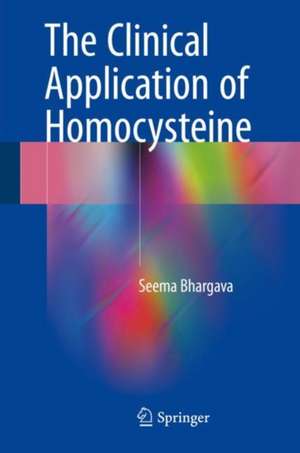The Clinical Application of Homocysteine
Autor Seema Bhargavaen Limba Engleză Hardback – 19 mar 2018
This book helps clinicians to optimally and appropriately utilize homocysteine levels in the diagnosis, prediction and management of and research into vascular disease and many other conditions. It also familiarizes readers with the pathophysiology and clinical implications of hyperhomocysteinemia. Laboratory investigations are gaining importance in the diagnosis and prognosis of patients, and as such, scientists and laboratorians are constantly attempting to identify new markers that will help in earlier diagnosis and better prognostication of conditions with high morbidity and mortality, as well as high prevalence. According to the WHO, developing countries are home to 80% of patients with coronary artery disease (CAD) and stroke – conditions with a mortality second only to cancer. Intensive research in these areas has resulted in the identification of homocysteine (declared the ‘marker of the millennium’) and several new markers for the diagnosis and prediction of CAD and stroke. The book is a valuable resource for clinicians and consultants in practice, as well as for postgraduate and undergraduate students of medicine, biotechnology and biochemistry.
| Toate formatele și edițiile | Preț | Express |
|---|---|---|
| Paperback (1) | 325.09 lei 38-44 zile | |
| Springer Nature Singapore – 5 feb 2019 | 325.09 lei 38-44 zile | |
| Hardback (1) | 365.46 lei 3-5 săpt. | |
| Springer Nature Singapore – 19 mar 2018 | 365.46 lei 3-5 săpt. |
Preț: 365.46 lei
Preț vechi: 384.70 lei
-5% Nou
Puncte Express: 548
Preț estimativ în valută:
69.93€ • 73.02$ • 57.75£
69.93€ • 73.02$ • 57.75£
Carte disponibilă
Livrare economică 25 martie-08 aprilie
Preluare comenzi: 021 569.72.76
Specificații
ISBN-13: 9789811076312
ISBN-10: 9811076316
Pagini: 96
Ilustrații: XIX, 96 p. 19 illus. in color.
Dimensiuni: 155 x 235 mm
Greutate: 0.34 kg
Ediția:1st ed. 2018
Editura: Springer Nature Singapore
Colecția Springer
Locul publicării:Singapore, Singapore
ISBN-10: 9811076316
Pagini: 96
Ilustrații: XIX, 96 p. 19 illus. in color.
Dimensiuni: 155 x 235 mm
Greutate: 0.34 kg
Ediția:1st ed. 2018
Editura: Springer Nature Singapore
Colecția Springer
Locul publicării:Singapore, Singapore
Cuprins
Introduction.- Discovery and metabolism.- Homocysteinemia and occlusive vascular disease.- Homocysteinemia and hypertension.- Homocysteinemia and its neurological effects.- Homocysteinemia in nephrology practice.- Homocysteinemia and oncology.- Homocysteinemia and otology.- Homocysteinemia and bones.- The body’s inherent defence against homocysteinemia.- Homocysteine and epigenetics.- Food fortification.
Notă biografică
Dr. Seema Bhargava obtained her DNB from Lady Hardinge Medical College, New Delhi and PhD from Sir Ganga Ram Hospital and Jamia Millia Islamia, New Delhi. She completed her postdoctoral studies at the Department of Physiology and Biophysics, University of Louisville School of Medicine, Louisville, Kentucky, USA
Dr. Bhargava is senior consultant and chair of the Department of Biochemistry at Sir Ganga Ram Hospital, and a professor at Ganga Ram Institute of Postgraduate Medical Education and Research (GRIPMER) and Guru Gobind Singh Indraprastha University. She was also an elected member of the National Academy of Medical Sciences. She is a lead assessor and technical assessor for the National Accreditation Board for testing and calibrating Laboratories (NABL) and also a member of the accreditation committee.
Her research focuses on identification of clinically relevant biochemical markers and their applications in various areas of medicine, such as neurology, Alzheimer’s disease, cardiovascular disease, and sepsis. She has published numerous papers in national and international indexed journals. She has guided several PhD and DNB scholars, and has been actively involved in training of MSc, BSc, nursing and DMLT students. She is on the editorial board of two journals and is a reviewer for several international journals.
Dr. Bhargava is senior consultant and chair of the Department of Biochemistry at Sir Ganga Ram Hospital, and a professor at Ganga Ram Institute of Postgraduate Medical Education and Research (GRIPMER) and Guru Gobind Singh Indraprastha University. She was also an elected member of the National Academy of Medical Sciences. She is a lead assessor and technical assessor for the National Accreditation Board for testing and calibrating Laboratories (NABL) and also a member of the accreditation committee.
Her research focuses on identification of clinically relevant biochemical markers and their applications in various areas of medicine, such as neurology, Alzheimer’s disease, cardiovascular disease, and sepsis. She has published numerous papers in national and international indexed journals. She has guided several PhD and DNB scholars, and has been actively involved in training of MSc, BSc, nursing and DMLT students. She is on the editorial board of two journals and is a reviewer for several international journals.
Textul de pe ultima copertă
This book helps clinicians to optimally and appropriately utilize homocysteine levels in the diagnosis, prediction and management of and research into vascular disease and many other conditions. It also familiarizes readers with the pathophysiology and clinical implications of hyperhomocysteinemia. Laboratory investigations are gaining importance in the diagnosis and prognosis of patients, and as such, scientists and laboratorians are constantly attempting to identify new markers that will help in earlier diagnosis and better prognostication of conditions with high morbidity and mortality, as well as high prevalence. According to the WHO, developing countries are home to 80% of patients with coronary artery disease (CAD) and stroke – conditions with a mortality second only to cancer. Intensive research in these areas has resulted in the identification of homocysteine (declared the ‘marker of the millennium’) and several new markers for the diagnosis and prediction of CAD and stroke. The book is a valuable resource for clinicians and consultants in practice, as well as for postgraduate and undergraduate students of medicine, biotechnology and biochemistry.
Caracteristici
Covers all aspects of homocysteine metabolism and its clinical impact Includes several diagrammatic interpretations of mechanism of action of homocysteine in various systems of the human body for easy understanding Includes suggestions as a clinical message at the end of each chapter References include the latest knowledge on the subject
